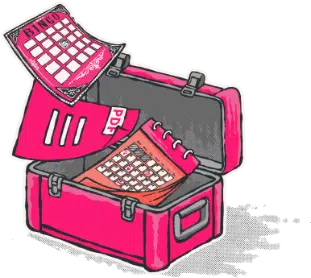Here is our list of the most helpful team building techniques.
Team building techniques are strategies for building conscientious teams that exert maximum effort. These techniques include interviewing the team, establishing a routine, and setting goals.
These tactics are similar to team building methods, team building strategies and team building best practices.
This list contains:
- inter-professional team building techniques
- agile team building techniques
- team trust building techniques
Alright, here is the list!
List of team building techniques
With all the information on team building available, beginning the process can seem overwhelming. The methods detailed in this post suggest a plan of action for shaping enthusiastic, cooperative, and communicative teams. From setting a routine to highlighting team building in company culture, here are the best team building techniques.
1. Interview the Team
Your team members are useful team building resources. While team building guides offer general advice, your teammates can provide more relevant and specific information. Many team building styles exist. Not every approach will work well for your team. By talking to your teammates before forming a plan of attack, you can save time by eliminating methods which are unlikely to achieve results.
You can gather your team’s opinions and ideas by taking a formal survey or by initiating informal conversations.
Helpful questions to ask:
- What kinds of team building activities interest you?
- What is your ideal team?
- What are our team’s current strengths and weaknesses?
- What kinds of changes would you like to see within our team?
While outside resources guide your process in theory, your teams’ observations provide an accurate representation of your team’s wants and needs.
Consulting the team grants members autonomy in the team building process. Instead of viewing team building as an obligation, teammates will recognize team building as a democratic and collaborative effort. Employees are more likely to assume ownership and take interest if you actively involve the group in the decision. By seeking your team’s advice you communicate respect, and respect is the cornerstone of teamwork. When you openly value your team members, your teammates’ satisfaction and output will increase.
Lastly, it is important not only to ask your teams’ opinions before team building, but also to ask for feedback during and after activities. Team building is a continual process, and you can only gauge effectiveness and improve the system when you know which components are working.
Here are lists of team building questions and employee survey questions.
2. Establish a Routine
Human beings crave predictability. When we know what to expect, we can plan and exercise some level of control. When unexpected incidents arise, we scramble to adjust and lose our equilibrium. Most of us have work routines, and sudden changes to those flows can fluster us and affect our productivity.
Team building activities work best as habits, not surprises. This approach conditions employees to think of team building as another aspect of the job as opposed to an interruption. Springing sudden activities or exercises on teams may frustrate or stress your team members. However, if you give your coworkers fair warning, then your employees can mentally prepare and free up schedules.
One simple way to notify teammates about team building time is to set a routine. Team building is an ongoing process, meaning that you and your team will need to flex your teamwork skills consistently. If you employ team building tactics at regular intervals, then your teams will acclimate easily.
For instance:
- Daily check-in on a group Slack channel
- Weekly 1:1 with a coworker
- Monthly team hangout
- Quarterly team challenge day
Knowing when to expect team building tasks prepares your teammates and saves you time. Setting a routine means you will not have to schedule tasks individually, thus freeing up time for you to focus on other priorities.
Get our free team building toolbox
- icebreaker games
- bingo cards
- DIY guides
 by teams at FedEx, Amazon, Deloitte and 73,930+ others
by teams at FedEx, Amazon, Deloitte and 73,930+ others

3. Remain Flexible
One of my past employers mandated regular team building activities, but allowed employees to pick dates and activities. Managers told teams to execute six events a year, but left teams to decide the details. Employees could opt out of events if busy or uninterested. This flexibility fostered good feelings among the staff. We voted on days and venues, and settled on a plan that appeased the majority of the group. No team member felt forced to participate in an inconvenient or uninteresting activity.
Flexibility is the difference between team building being stressful or fun. Adopting a flexible approach alerts employees that organizations care about balance. Imposing too many restrictions or demands can stir up resentment and tank morale. Granting team members freedom to shape the process communicates respect and relieves tension. Flexible team building feels more like a collaboration than an order.
Examples:
- Set a timeframe instead of a specific time
- Vary activities and time slots
- Provide multiple options and let employees choose
- Remain open to suggestion and willing to alter plans
An open-minded approach is more convenient for your teammates, inspiring gratitude amongst your team. Though offering options may initially seem like a lot of effort, allotting freedom shifts the bulk of the planning and scheduling onto the employees, which in turn actually lessens your workload.
4. Think Simple & Small
Bagel Friday was a big deal at my last job. At the end of every week, managers bought bagels and cream cheese for the whole company and allowed every employee leisure to enjoy the treat in the break room. The act was so simple, but so effective at boosting morale.
Team building opportunities do not need to be flashy or revolutionary. Simple, small gestures often make a big difference. Even something as simple as a smile and a wave can build bonds and cultivate feelings of belonging.
Simple team building efforts:
- Email teammates a weekly thought or question and ask employees to reply all
- Start an initiative to complement least one colleague a week
- Begin every meeting with a short icebreaker
- Create a team “bulletin board” where teammates can share good news, uplifting notes, and fun facts
- Treat employees to shareable snacks like pizza or donuts
- Introduce new employees and maintain a directory of existing employees
Overcomplicating the team building process can lead to confusion and disappointing results. Small, simple concepts require minimal effort and creativity but achieve considerable impact, and can be one of the most useful inter-professional team building techniques.
Here is a guide to team building emails.
5. Set Goals
Setting team building goals means choosing achievable results and reverse engineering methods based on the desired outcome. You can better plan your activities if you know what changes you want to achieve.
Goal examples:
- Boost morale
- Increase productivity
- Strengthen relationships
- Build trust
- Improve communication
- Develop group problem solving ability
- Practice compromise and negotiation
- Intensify cooperation
The above list suggests general goals, but you will want to customize objectives to fit your team. The more specific, the better. For instance, “improve communication” is vague, but “cut down on emails by 25%” or “finish meetings within 30 minutes,” is concrete. If you set measurable goals, then you will gain a clearer picture of whether you hit your targets.
Teams gain a sense of accomplishment upon meeting objectives. Team members work together to win, which bolsters team bonding. However, if teams are unsure of the aim, then employees may perceive a lack of progress. For best results, set clear goals and celebrate triumphs. Clarifying objectives gives team direction and provides a tool to evaluate success and growth. Setting goals gives your team collective purpose. Not to mention, establishing high standards makes work more meaningful, which heightens employee satisfaction.
Learn more about the goals of team building.
6. Create a Team Building Culture
If you incorporate team building into your company’s core culture and values, then you will automate much of the team building process. Teammates will identify and seize opportunities to strengthen bonds. You will not need to provoke or prompt every employee interaction. Your team members may plan a potluck, arrange a happy hour, throw a teammate a party, or start a group chat without a word from you. Your employees might excitedly approach you with team building suggestions instead of rolling eyes when you announce an activity. When you prioritize cooperation and camaraderie, you compel coworkers to relate to each other naturally.
Talking about teamwork is not enough to inspire action. The best way to build a culture of connectivity is to model the desired behavior.
Examples:
- Announce and welcome new employees
- Congratulate coworkers regularly
- Make time to talk, whether to answer questions, address concerns, or casually chat
- Take an interest in your employees’ personalities and interests
- Offer assistance and advertise yourself as a resource
Employees will follow your lead. When your coworkers understand that you value teamwork, team members actively seek out opportunities to demonstrate cooperation and deepen bonds with coworkers.
This approach is one of the most effective team trust building techniques.
Here is a list of tips on how to improve company culture and a list of types of team building.
7. Seize Natural Opportunity
Seizing opportunities is one of the best agile team building techniques. This approach means capitalizing on existing circumstances instead of contriving new or unnatural situations. For instance, instead of single handedly planning an outing like a painting class or a camping trip, you can wait for your employees to mention an event like a festival or game and then suggest making the affair a team outing.
Other ideas:
- Swing by an employee happy hour and buy teammates a first round of drinks
- Collectively fundraise for a coworker’s charity cause
- Celebrate special occasions like birthdays, work anniversaries, and graduations
- Use existing tools like Basecamp, Slack, or GChat to create an employee forum
- Form workplace-specific holidays and traditions. For instance, buying the whole office hot chocolate during the first snowstorm of the year or allowing employees to wear jerseys to work the day after the home team wins a game
Employees complain when team building feels forced. When you turn employees’ existing interests into opportunities for team bonding, activities feel more organic. Recognizing and embracing spontaneous occasions for team engagement results in more responsive and cohesive groups.
Final Thoughts
Team building techniques provide leaders with instructions and blueprints to help guide the team development process. By following these tested tactics, managers can speed up the relationship forming process and improve the odds of success for increasing teamwork.
Each team is unique, and what works for one group may need retooling for another. Sometimes, leaders need to switch up tactics or use a combination of approaches to fully bring out a team’s potential.
Next, check out these lists of employee engagement campaigns, team building program examples, and team building exercises.
We also have a list of the best team building tools.




